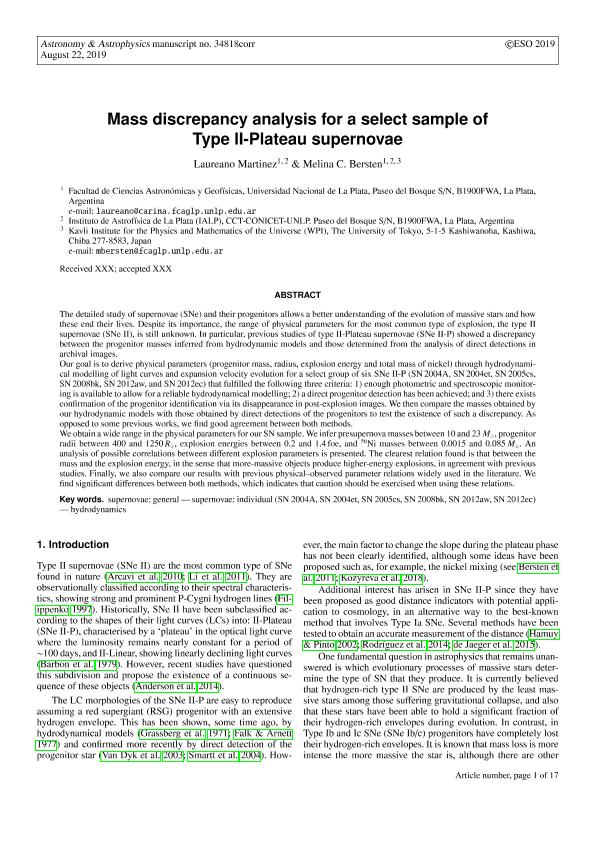Artículo
Mass discrepancy analysis for a select sample of Type II-Plateau supernovae
Fecha de publicación:
16/09/2019
Editorial:
EDP Sciences
Revista:
Astronomy and Astrophysics
ISSN:
0004-6361
Idioma:
Inglés
Tipo de recurso:
Artículo publicado
Clasificación temática:
Resumen
The detailed study of supernovae (SNe) and their progenitors allows a better understanding of the evolution of massive stars and how these end their lives. Despite its importance, the range of physical parameters for the most common type of explosion, the type II supernovae (SNe II), is still unknown. In particular, previous studies of type II-Plateau supernovae (SNe II-P) showed a discrepancy between the progenitor masses inferred from hydrodynamic models and those determined from the analysis of direct detections in archival images. Our goal is to derive physical parameters (progenitor mass, radius, explosion energy and total mass of nickel) through hydrodynamical modelling of light curves and expansion velocity evolution for a select group of six SNe II-P (SN 2004A, SN 2004et, SN 2005cs, SN 2008bk, SN 2012aw, and SN 2012ec) that fulfilled the following three criteria: (1) enough photometric and spectroscopic monitoring is available to allow for a reliable hydrodynamical modelling; (2) a direct progenitor detection has been achieved; and (3) there exists confirmation of the progenitor identification via its disappearance in post-explosion images. We then compare the masses obtained by our hydrodynamic models with those obtained by direct detections of the progenitors to test the existence of such a discrepancy. As opposed to some previous works, we find good agreement between both methods. We obtain a wide range in the physical parameters for our SN sample. We infer presupernova masses between 10 and 23 M⊙, progenitor radii between 400 and 1250 R⊙, explosion energies between 0.2 and 1.4 foe, and 56Ni masses between 0.0015 and 0.085 M⊙. An analysis of possible correlations between different explosion parameters is presented. The clearest relation found is that between the mass and the explosion energy, in the sense that more-massive objects produce higher-energy explosions, in agreement with previous studies. Finally, we also compare our results with previous physical–observed parameter relations widely used in the literature. We find significant differences between both methods, which indicates that caution should be exercised when using these relations.
Archivos asociados
Licencia
Identificadores
Colecciones
Articulos(IALP)
Articulos de INST.DE ASTROFISICA LA PLATA
Articulos de INST.DE ASTROFISICA LA PLATA
Citación
Martinez, Laureano; Bersten, Melina Cecilia; Mass discrepancy analysis for a select sample of Type II-Plateau supernovae; EDP Sciences; Astronomy and Astrophysics; 629; A124; 16-9-2019; 1-17
Compartir
Altmétricas




